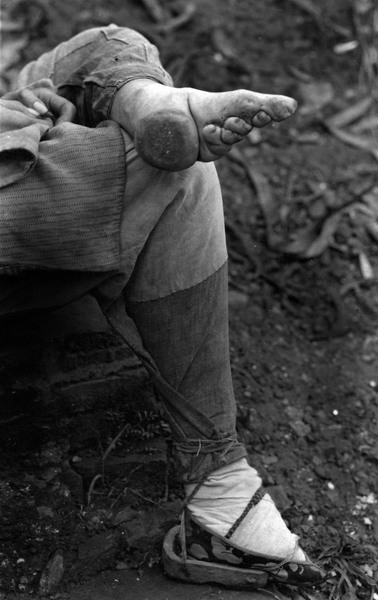
“A ‘lily footed woman of China (Foot Binding).” (1949) black and white photograph. Bridgeman Images. Accessed February 14, 2016. https://www.bridgemaneducation.com/en/asset/1729502/summary?context=%7B%22route%22%3A%22assets_search%22%2C%22routeParameters%22%3A%7B%22_format%22%3A%22html%22%2C%22_locale%22%3A%22en%22%2C%22filter_text%22%3A%22%5C%22foot+binding%5C%22%22%7D%7D
This photograph that was taken by an unknown photographer in the year 1949 called A ‘lily footed woman of China (Foot Binding), found on the Bridgemen Education database suggests that despite the value of the appearance of bound feet in traditional Chinese culture to display beauty and civility[1], the exposure of the disfigured feet underneath represents only the consequences of this practice and disregards any of the meanings behind it.
thesis claim?
Around the start of the twentieth century, outsiders were photographing women’s bound feet without the cloth they bound their feet with and without their lotus shoes.[2] They were narrating the story of the practice for the Chinese by changing the depiction of bound feet in publications from focusing on the fashion of the lotus shoes paired with patterned attire, to the disfigured feet. An example of an illustration from the nineteenth century is from Ellen Johnston Liang’s article,“Visual Evidence for the Evolution of ‘Politically Correct’ dress for Women in Early Twentieth Century Shangai,” and this illustration shows the bound feet paired with clothing that was considered elegant at the time.[3] In comparison to this photograph that was taken in the mid-nineteenth century which includes both a bound foot and an unbound foot and the woman appears to be someone from the lower-class. The woman is wearing trousers and shirt made probably of cotton and put together with patches of material, no design or embroidery. In this same style are the lotus shoes, very simple. Also during this time footbinding was available to women of all social classes and you couldn’t distinguish who belonged to what social class, just by having their feet bound.[4] The photographer protrayed this by not including the face or upper body of the woman so the viewer couldn’t tell anything else about her social class, apart from the bound feet and some of the attire.
The background of this photograph is in a rural environment, and instead of the bounded foot being raised by a decorated foot rester that is usually used when women from a higher social class were photographed (as seen in a photograph on Professor Shu-Chin’s footbinding presentation) it is raised a bit by a piece of rock.[5] This symbolizes the women’s social status, but also how important it was for women’s feet to be bound, which at the time the photograph was taken, wasn’t.[6]This photograph is composed to draw your attention to the contrast being made by the photographer between the bound foot and the unbound foot. The bound foot looks small, perfect and pristine, but the unbound foot is dirty and disfigured.
could start analysis from this paragraph with the denotations and connotations of the background, the exposed bound foot, the faceless body, black/white photo ….
[1] Dorothy Ko, “The Body as Attire: The Shifting Meanings of Footbinding in Seventeenth-Century China,” Journal of Women’s History 8, no.4 (Winter 1997): 11
[2] Dorothy Ko, “Bondage in Time: Footbinding and Fashion Theory.” The Journal of Dress, Body and Culture 1. No. 1 (1997): 21
[3] Ellen Johnston Liang, “Visual Evidence for the Evolution of ‘Politically Correct’ dress for Women in Early Twentieth Century Shangai,” Nan Nu-Men, Women and Gender in Early and Imperial China 5, no.1 Edited by Leiden Brill (April 2003): 97
[4] Dorothy Ko, “Bondage in Time: Footbinding and Fashion Theory.” The Journal of Dress, Body and Culture 1. No. 1 (1997): 21
[5] Professor Shu Chin, “Footbinding Presentation” slide 9, January 31, 2016
[6] Dorothy Ko, “Bondage in Time: Footbinding and Fashion Theory.” The Journal of Dress, Body and Culture 1. No. 1 (1997): 21
